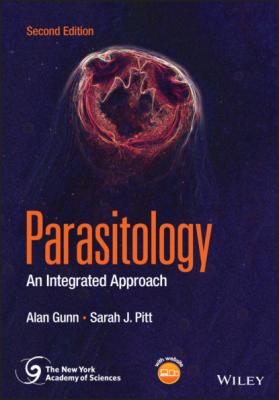Parasitology. Alan Gunn
Чтение книги онлайн.
Читать онлайн книгу Parasitology - Alan Gunn страница 12
 it is instructive to recognise how an individual organism might interact with other members of the same species, other species of protozoa and helminths, and other classes of microorganism within a particular host. The effects on the host of harbouring a particular species of parasite are influenced by various host factors, including genetic constitution, immune status, and behaviour. Also, for parasites of humans, consideration of social, religious, and cultural factors is often necessary. We therefore call this book ‘Integrated Parasitology’ to emphasise how parasites influence, and are influenced by, a complex web of interacting factors. All the material from the first edition has been extensively revised and updated. In addition, many new illustrations are included, and the on‐line support material has been expanded.
it is instructive to recognise how an individual organism might interact with other members of the same species, other species of protozoa and helminths, and other classes of microorganism within a particular host. The effects on the host of harbouring a particular species of parasite are influenced by various host factors, including genetic constitution, immune status, and behaviour. Also, for parasites of humans, consideration of social, religious, and cultural factors is often necessary. We therefore call this book ‘Integrated Parasitology’ to emphasise how parasites influence, and are influenced by, a complex web of interacting factors. All the material from the first edition has been extensively revised and updated. In addition, many new illustrations are included, and the on‐line support material has been expanded.
We divide the book into a series of conventional chapters, but because we wish to show how topics are inter‐related, the reader will find certain subjects are picked up, put down, discussed in more detail elsewhere, and then returned to in a later chapter. This is also a good way of learning since it is better to take in bite sized chunks of information and return to them frequently rather than attempt to grasp all aspects of a topic in a single sitting. We first introduce the concept of parasitism and the terms used by parasitologists to describe parasite lifestyles. There then follows a brief consideration of taxonomy after which, in Chapters 3–7, we introduce some of the ‘key players’ explain their basic biology and how they interact with one another. Within this second edition, we have included more diagrams of parasite life cycles, but the reader is also recommended to consult the excellent online resource available at the DPDx – CDC Parasitology Diagnostic Web Site (http://dpd.cdc.gov/dpdx). There follows a chapter on parasite transmission in which we consider, amongst other topics, not only how parasites exploit other animals as vectors and intermediate hosts but also how they manipulate their host’s behaviour to increase the chances of transmission. We provide separate chapters on immunology and pathology, but in truth, it is virtually impossible to separate these topics because they are so inter‐dependent. Chapter 12 provides a counterbalance to the bad press that parasites receive. Parasites can not only be used for the treatment of medical conditions but also (in small doses) actually be good for us. Before one can begin to study parasites, one needs to be able to find them and count them. Even if the host is dead, this is not necessarily as simple as it sounds. Correct parasite identification is essential before treatment can be given and to determine whether a control programme is performing effectively. We therefore devote Chapter 13 to parasite diagnosis that encompasses techniques ranging from straightforward light microscopy to advanced molecular biology. We then consider methods of treating and vaccinating against parasites in separate chapters before ending with a chapter on control strategies.
In the spirit of integration, we have provided web‐based support material via the publisher’s website. This includes the numerous photographs of parasites that we could not include in the book without increasing its size and cost. There are also quizzes based on each chapter, and some ideas for projects that do not require access to complex laboratory facilities or use laboratory animals such as mice, rats, and rabbits.
Alan Gunn and Sarah J. Pitt, 2021
About the Companion Website
This book is accompanied by a companion website:
www.wiley.com/go/gunn/parasitology2
This website includes:
Figures
SAQs and answers
MCQs and answers
Practical exercises
1 Animal Associations and the Importance of Parasites
CONTENTS
1.5 The Co‐evolution of Parasites and Their Hosts
1.5.1 The Red Queen’s Race Hypothesis
1.5.2 Parasites in the Fossil Record
1.5.3 Parasites and the Evolution of Sexual Reproduction
1.6 Parasitism as a ‘Lifestyle’: Advantages and Limitations
1.7 The Economic Cost of Parasitic Diseases